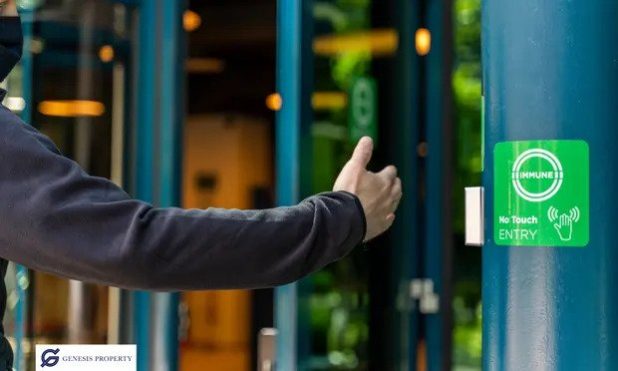“Human health depends on staying away from viruses and bacteria, so why don’t we all just kill our gut bacteria with antibiotics?”
I’m sure this is fine.
It will just um, prevent our breathing from uhhhh, you know – making the, uh… our breathing from making the weather too warm.
We don’t want to get all sweaty, after all. That would be really bad, if we, uh, you know… got really sweaty.
Not so long ago it may have seemed more like a futuristic vision of the workplace – or a hospital.
But the hands-free door handles, self-cleaning surfaces, antimicrobial paint, air-monitoring display tools, UV light disinfection robots, and 135 other measures at an office block in Bucharest are here to stay, say the creators behind what they are touting as one of the world’s most virus-resilient workplaces, which they hope will become the new normal in office design.
Entering H3, a five-storey building in a western neighbourhood of the Romanian capital, is like learning the steps to a new dance. A flick of the wrist opens the door, and a red line marks the spot at which to stand from where a thermal body camera 2 metres away scans arrivals for signs of fever. Those who are “green-lighted” can follow the tracks to the self-clean lift, step on one of two foot pads and be transported through the building, safe in the knowledge that a UV lighting disinfection system installed in the ventilation shafts is keeping them infection-free between floors.
Anyone whose head flashes red on the screen, however, is whisked away by a plastic-gloved “immune steward” into a nearby quarantine room: a glass box with a panic button and its own internal ventilation system shut off from the rest of the building. A “Viruskiller” apparatus on the wall, boasting three levels of fan strength, promises to remove anything nasty such as pollutants, mould or spores that may be infecting the air, with back up provided by a sanitising UV light on the wall.
This view of the future may alarm some. Modelled on hospital technology, is this sanitised environment a place to which employees will want to return once the pandemic is considered sufficiently under control? In Romania, just as elsewhere in Europe, the majority of office workers were confined to home for much of the past 18 months. Surveys show many are nervous about the prospect of coming back.
“The point is to reassure them. We don’t want people to panic,” says Gavin Bonner, one of the main coordinators behind the Immune building standard project, which has brought together health professionals, architects, engineers, IT and building managers from around the world to help corporations prepare for post-pandemic life.
The publicly available standard, trademarked Immune, has already been applied to several buildings in the UK. Its developers include the leading Romanian property company Genesis, also the H3 landlord, and the project has cost about €1m (£850,560). More than a dozen other buildings, from the US to Singapore, are in the process of obtaining their Immune certification, according to Liviu Tudor, the CEO of Genesis. The H3 building, as the most protected space so far, acts as the showroom, incorporating all 135 of the recommended measures.
…
Elsewhere, simpler measures include doors fitted with attachments allowing them to be opened with an elbow or lower arm. Fittings and floors have been given rounded edges wherever possible, as fewer corners mean germs have less chance to gather.
Toilet cubicles are floor to ceiling, as it is considered safest for people to be enclosed in their own cubicle with air conditioning as there is not the recommended 2-metre distance from the next toilet. At night, a 1.2 metre tall robot traverses the building, using UV light to disinfect and eliminate pathogens. During the day, hydrogen peroxide ions are emitted from strategic points in the ventilation system: transparent panels have been fitted in the ceiling so that the mechanism can be seen. “Visibility is everything,” says Bonner.
Who would have thought that it would be the Romanians who would finally deliver paradise unto us?
I’ll tell you who thought it:
I did.
Elvis.
Dunderhoff.
Of course, the Brits are copying the Romanians.
Classrooms in England are to be fitted with air quality monitors when state schools and colleges reopen after the summer holidays, in an effort improve ventilation and combat the spread of Covid.
The decision announced by the education secretary, Gavin Williamson, comes after a vociferous campaign by school staff unions for better ventilation, with research suggesting that the Covid virus mainly transmits via airborne particles, making enclosed spaces likely breeding grounds for infection.
Starting in September, the Department for Education (DfE) will spend £25m on providing 300,000 CO2 monitors to alert staff and students if CO2 levels rise, meaning that fresh air is failing to circulate.
…
Other measures from the start of the school year, which is next week in some parts of England, will include students continuing with twice-weekly Covid testing, starting with two tests to be administered onsite to secondary and college students on or before the start of term.
The British are also really worried that um, that uh, ehh…
That the uh, that um – that the breathing will make the uh, the weather too hot and the uh. The um.
That everyone will get all sweaty.
And also the um.
The uh.
Everyone is going to uh.
There’s a um.
The uh.
There’s a deadly virus that is killing everyone. Everyone is going to die unless we do this.
 Daily Stormer The Most Censored Publication in History
Daily Stormer The Most Censored Publication in History





